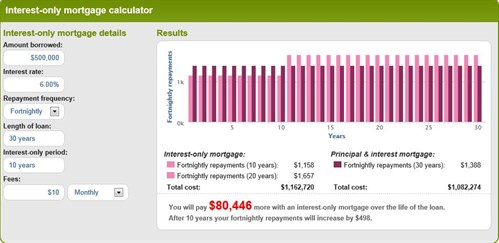ASIC has released a suite of online tools to help consumers better understand the risks of interest-only mortgages, to complement its review of loan providers' compliance with responsible lending laws.
The new tools, available on ASIC's MoneySmart website at moneysmart.gov.au, include:
- an interest-only mortgage calculator to help consumers work out the real cost of an interest-only home loan, and
- an interest-only loan infographic that shows the journey of borrowers who take out different types of mortgage.
ASIC Deputy Chairman, Peter Kell, said while ASIC's review had found that banks and other lenders needed to lift their game to ensure compliance with responsible lending obligations, consumers can help themselves by doing their homework before taking on such a large financial commitment.
'For most Australians, a mortgage is one of the most significant financial decisions they will make in their lives,' Mr Kell said.
'While an interest-only mortgage may be attractive due to their initial lower repayments, they generally cost more in the long run. Some lenders have also started charging higher interest rates on interest-only mortgages compared to principal and interest mortgages.
'Anyone thinking of taking out an interest-only mortgage needs to have a clear plan of action when the interest-only period ends to ensure they can afford the repayments, which may increase significantly," said Mr Kell.
Mr Kell suggests consumers who are considering an interest-only mortgage, or who already have one at present, should consider the following:
- ensure you can afford the increased repayments once the interest-only period ends, and also factor in an interest rate rise
- the principal of the loan will not reduce while you are making interest-only repayments
- using an offset account to reduce the cost of an interest-only mortgage will only work if you can keep making these extra repayments without making any withdrawals. If you are tempted to dip into your offset account, then you might be better off with a principal and interest mortgage instead.
ASIC's recent probe into interest-only mortgages reinforced the fact that lenders and brokers need to meet responsible lending obligations and ensure the interest-only loans they arrange meet their customers' requirements and objectives.
'We expect that lenders and brokers arranging interest-only mortgages would do so in a way that is consistent with their customers' plans,' Mr Kell said.
Background
On 20 August 2015, ASIC released a report of its review into how lenders provided interest-only mortgages to both investors and owner occupiers (refer: 15-220MR). The review found that lenders providing interest-only mortgages needed to lift their standards to meet important consumer protection laws.
ASIC's MoneySmart website provides trusted and impartial guidance and online tools for Australians on issues relating to money and finances. Visit ASIC's MoneySmart at moneysmart.gov.au.
Australia is currently experiencing low interest rates. Consumers should build in a buffer over the minimum repayment for any interest rate rises and increases in repayments, especially if they have taken out an interest-only mortgage.
Example: $500,000 mortgage over 30 years with a constant interest rate of 6%
- For a principal and interest loan, a consumer would pay around $582,274 in interest over the life of the loan.
- For an interest-only loan with a 5-year interest-only period, a consumer would pay around $619,493 in interest (an extra $37,219 over the life of the loan) and have to find an extra $332 per fortnight in repayments after 5 years.
- If the interest-only period was extended to 10 years, a consumer would pay around $662,720 in interest (an extra $80,446 over the life of the loan) and have to find an extra $498 per fortnight in repayments after 10 years.
Example image from ASIC's MoneySmart interest-only calculator
